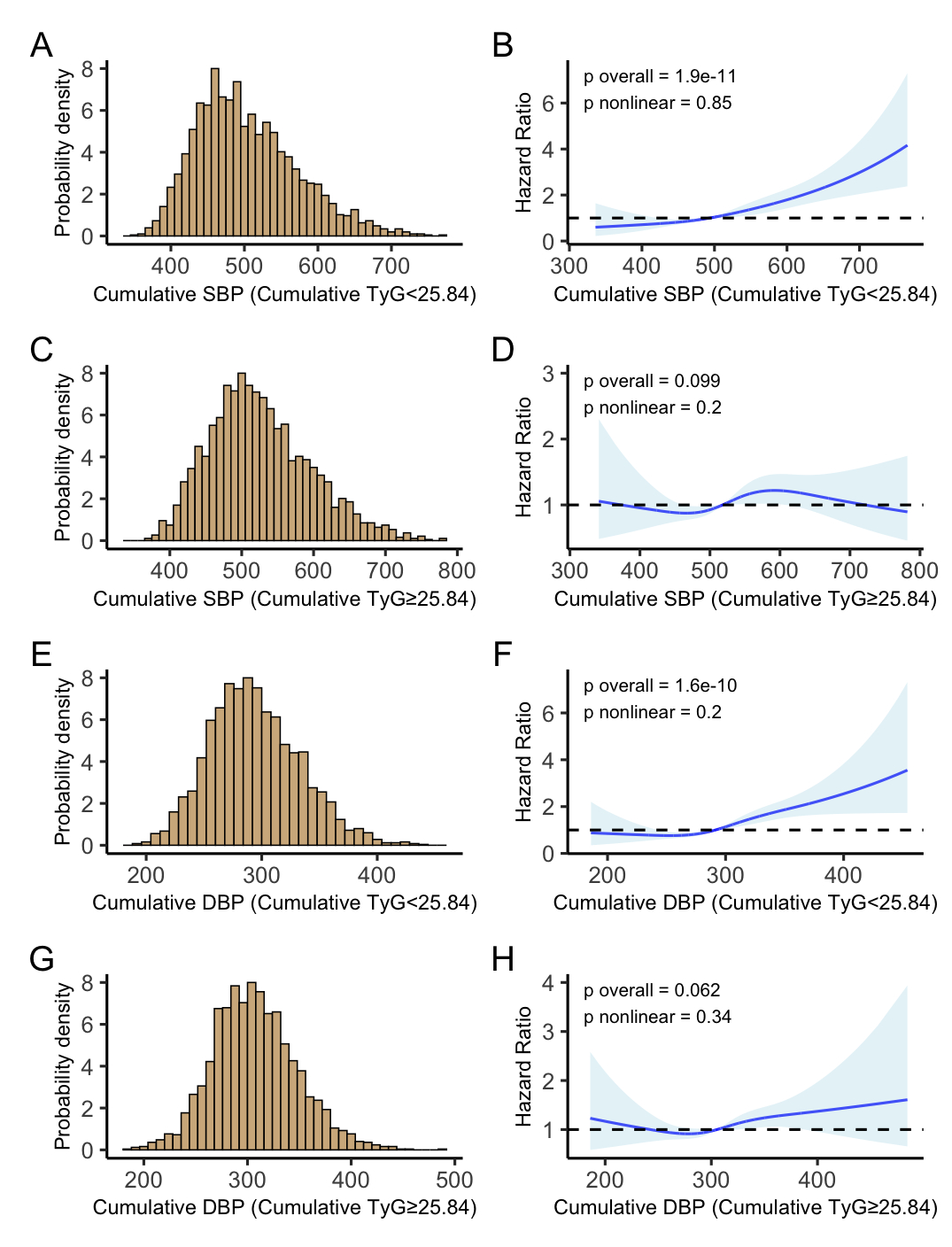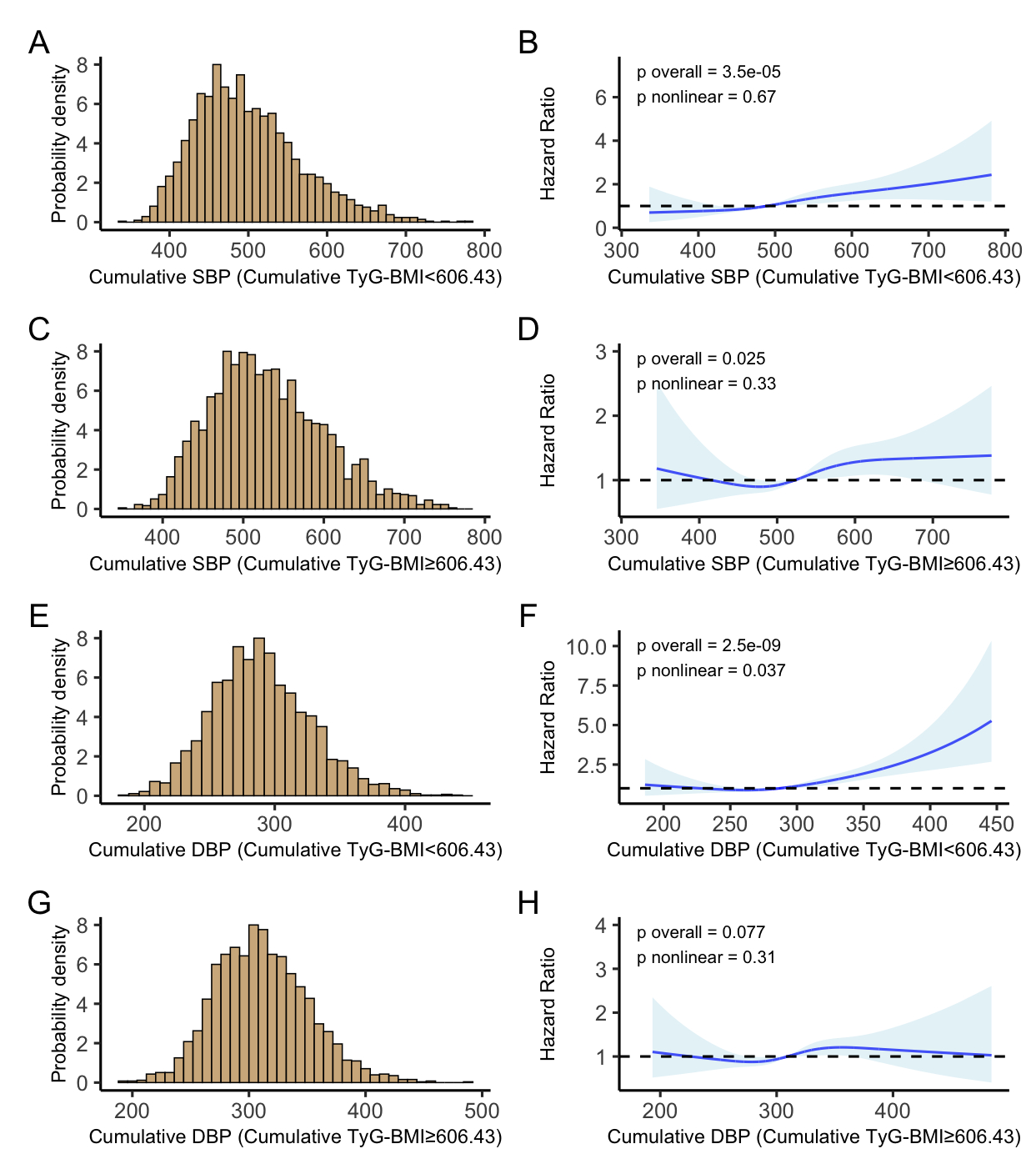Final ID: P-135
Evaluating the Impact of Cumulative Blood Pressure and Metabolic Indicators on Long-Term Cardiovascular Risk: Insights from a 9-year Nationwide Prospective Cohort Study
Abstract Body: Background
Cardiovascular diseases (CVD) are a global health challenge, particularly for older adults. Blood pressure and the Triglyceride-Glucose (TyG) index, an insulin resistance indicator, are key predictors of cardiometabolic risks.
Methods
Using data from the China Health and Retirement Longitudinal Study (CHARLS), this study followed participants without baseline CVD over 9 years. We stratified subjects by cumulative TyG and TyG-BMI indices, applying Cox proportional hazards adjusted by age and gender, and restricted cubic spline regression for CVD risk evaluation.
Results
From 11,847 participants, 4,751 were analyzed, mainly females (55.25%), with a median age of 57. BMI, TyG, and TyG-BMI indices increased significantly (23.16 to 23.51 for BMI; 8.59 to 8.62 for TyG, 199.14 to 204.22 for TyG-BMI) over 4 years. Participants were categorized based on cumulative TyG and TyG-BMI medians at 25.84 and 606.43, respectively. In the lower TyG group, each SBP unit increment raised CVD risk by 0.5% at 4 years (HR = 1.005, 95% CI 1.003–1.007, p<0.001) and 9 years (HR = 1.005, 95% CI 1.004–1.006, p<0.001). Each 10-unit rise in cumulative DBP corresponded to an 8-9% higher CVD risk at the 4 and 9-year follow-ups. In the higher TyG group, SBP increases were significantly associated with CVD risk changes. Each 10-unit DBP rise corresponded to a non-significant 2% risk elevation at 4 years, but a significant 3% risk increase at 9 years (HR = 1.003, 95% CI 1.000–1.005, p=0.023). For those with a TyG-BMI below 606.43, minor SBP increases significantly impacted CVD risk at both 4 and 9 years. Meanwhile, each 10-unit DBP increment resulted in a 6-8% risk increase, which grew over time. Above a TyG-BMI of 606.43, SBP changes resulted in a notable 2% risk rise by 9 years, and 10-unit DBP increases resulted in a 2-3% risk rise by 9 years. Restricted cubic spline regression showed the 4 and 9-year CVD risk increased with each rise in cumulative SBP and DBP when cumulative TyG was <25.84 or cumulative TyG-BMI <606.43, and DBP had a more profound impact. In contrast, trends were unclear when cumulative TyG ≥25.84 or cumulative TyG-BMI ≥606.43.
Conclusion
Cumulative SBP and DBP increases are linked to higher CVD risks, especially in individuals with lower cumulative TyG or TyG-BMI indices. DBP effects were more substantial, particularly noticeable over 9 years. This study underscores the nuanced impacts of blood pressure and metabolic indicators on long-term cardiovascular health.
Cardiovascular diseases (CVD) are a global health challenge, particularly for older adults. Blood pressure and the Triglyceride-Glucose (TyG) index, an insulin resistance indicator, are key predictors of cardiometabolic risks.
Methods
Using data from the China Health and Retirement Longitudinal Study (CHARLS), this study followed participants without baseline CVD over 9 years. We stratified subjects by cumulative TyG and TyG-BMI indices, applying Cox proportional hazards adjusted by age and gender, and restricted cubic spline regression for CVD risk evaluation.
Results
From 11,847 participants, 4,751 were analyzed, mainly females (55.25%), with a median age of 57. BMI, TyG, and TyG-BMI indices increased significantly (23.16 to 23.51 for BMI; 8.59 to 8.62 for TyG, 199.14 to 204.22 for TyG-BMI) over 4 years. Participants were categorized based on cumulative TyG and TyG-BMI medians at 25.84 and 606.43, respectively. In the lower TyG group, each SBP unit increment raised CVD risk by 0.5% at 4 years (HR = 1.005, 95% CI 1.003–1.007, p<0.001) and 9 years (HR = 1.005, 95% CI 1.004–1.006, p<0.001). Each 10-unit rise in cumulative DBP corresponded to an 8-9% higher CVD risk at the 4 and 9-year follow-ups. In the higher TyG group, SBP increases were significantly associated with CVD risk changes. Each 10-unit DBP rise corresponded to a non-significant 2% risk elevation at 4 years, but a significant 3% risk increase at 9 years (HR = 1.003, 95% CI 1.000–1.005, p=0.023). For those with a TyG-BMI below 606.43, minor SBP increases significantly impacted CVD risk at both 4 and 9 years. Meanwhile, each 10-unit DBP increment resulted in a 6-8% risk increase, which grew over time. Above a TyG-BMI of 606.43, SBP changes resulted in a notable 2% risk rise by 9 years, and 10-unit DBP increases resulted in a 2-3% risk rise by 9 years. Restricted cubic spline regression showed the 4 and 9-year CVD risk increased with each rise in cumulative SBP and DBP when cumulative TyG was <25.84 or cumulative TyG-BMI <606.43, and DBP had a more profound impact. In contrast, trends were unclear when cumulative TyG ≥25.84 or cumulative TyG-BMI ≥606.43.
Conclusion
Cumulative SBP and DBP increases are linked to higher CVD risks, especially in individuals with lower cumulative TyG or TyG-BMI indices. DBP effects were more substantial, particularly noticeable over 9 years. This study underscores the nuanced impacts of blood pressure and metabolic indicators on long-term cardiovascular health.
More abstracts on this topic:
A multi-proteomic Risk Score Predicts Adverse Cardiovascular Outcomes in Patients with Angina and Non-obstructive Coronary Artery Disease
Huang Jingwen, Lodhi Rafia, Lodhi Saleha, Eldaidamouni Ahmed, Hritani Wesam, Hasan Muhammet, Haroun Nisreen, Quyyumi Arshed, Mehta Puja, Leon Ana, Ko Yi-an, Yang Huiying, Medina-inojosa Jose, Ahmed Taha, Harris Kristen, Alkhoder Ayman, Al Kasem Mahmoud
DENND5B Plays a Role in Triglyceride-Rich Lipoprotein Secretion from Human Enterocytes and HepatocytesHage Olivia, Neupane Khaga, Voy Clairity, Karakashian Alexander, Gordon Scott



